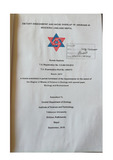Please use this identifier to cite or link to this item:
https://elibrary.tucl.edu.np/handle/123456789/1473| Title: | Dietary Assesment and Niche Overlap of Anurans in Western Lowland Nepal |
| Authors: | Sapkota, Suman |
| Keywords: | Diet;Assessment |
| Issue Date: | 2019 |
| Publisher: | Central Department of Zoology |
| Abstract: | Diet of organism plays important role to understand the ecology, behaviour and overall life processes. Present study was carried out in three different habitat types (cropland, forest and forest edge) of Western Terai of Nepal to explore dietary habit and niche overlap among the anurans. Nocturnal time-constrained visual encounter line transect method was employed for anuran surveys and the diet of the captured individuals were collected by using non-lethal stomach flushing technique. Nineteen (10.11%) individuals out of 169 stomach flushed were found with empty stomach. The diet contained 685 prey items which were categorized into 13 taxonomic groups. Hymenoptera (35.79%) and Coleoptera in Hop lobatrachus crassus. The relation between the body size and the weight of prey found significantly positive (R x 2 =0.103, p<0.002). Among all species, H. tigerinus showed the positive relationship between both body size and body weight with prey weight. There was no significant relationship between the habitat types and dietary preferences. The result from Non-Metric Multidimensional Scaling revealed that there was high degree of dietary niche overlap between H. crassus, H. tigerinus, Minervarya teraiensis, Euphlyctis cyanophlyctis and Duttaphrynus among them, M. teraiensis had the highest niche breadth (BA = 0.501). Similarly, the niche breadth of H. crassus and Duttaphrynus; H. tigerinus and E. cyanophlyctis was quiet similar. In other hand, dietary niche overlap was found the highest in medium sized (SVL < 50 mm) frogs (Ojk = 0.97) whereas the large sized frogs (SVL > 50 mm) had comparatively lower niche overlap (Ojk = 0.89). Prey preferences with regards to different body size of anurans might help in coexistence of various species in ame habitats. Furthermore, this study suggests the need of detailed study on amphibians and their diets. Such studies help for the conservation of amphibians including other wetland dependent fauna. |
| URI: | http://elibrary.tucl.edu.np/handle/123456789/1473 |
| Appears in Collections: | Zoology |
Files in This Item:
| File | Description | Size | Format | |
|---|---|---|---|---|
| Suman_Sapkota_CD.pdf | 3.38 MB | Adobe PDF |  View/Open |
Items in DSpace are protected by copyright, with all rights reserved, unless otherwise indicated.
